By: Themistokles von Eckenbrecher
Week: 1
In 'View of Laerdalsøyri, on the Sognefjord,' Themistokles von Eckenbrecher painted a view of Sognefjord, the longest and deepest fjord in Norway. Majestic green mountains stretch up to the clouds and tower over the tiny people below. The red, brown, and white homes of Laerdalsøyri cluster along the far shore of the fjord. A mother and child watch as ladies and gentlemen ride in carriages pulled by trotting horses down a road. Two boats float on the serene surface of the water. A man stands and fishes from one of the boats.
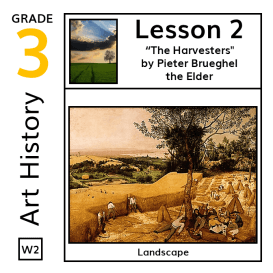
By: Pieter Brueghel the Elder
Week: 2
In 'The Harvesters,' Pieter Brueghel the Elder captures the laborious work of peasants during harvest time. A few peasants wield sharp scythes to reap golden grains of wheat from the field. Other peasants tie bundles of wheat into sheaves, then prop the sheaves upright into stooks, which allow the wheat to dry. Other peasants sit on sheaves and rest in the shade of a tree, eating bread, pears, and perhaps milk or porridge from bowls. Take a closer look to see a steeple peeping from between trees in the background. Also in the distance, birds fly over fields, a hay wagon rolls over a road, children play, and people bathe in a pond, travel over a hill, and sail on the water.
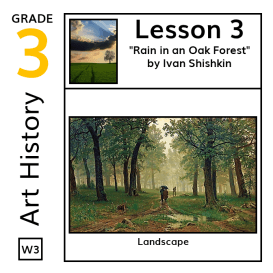
By: Ivan Shishkin
Week: 3
Ivan Shishkin's 'Rain in an Oak Forest' shows three figures picking their way up a muddy road. The man farthest from the viewer carries what appears to be a gun. The lady lifts her brown skirts and holds the gentleman's arm as they shelter under an umbrella. The emerald green of the foliage glows bright in the foreground, despite the fog graying the colors in the distance. The painting enables the viewer to imagine the cool spritz of misty air against their skin and the splashing sound of footsteps through the puddles.
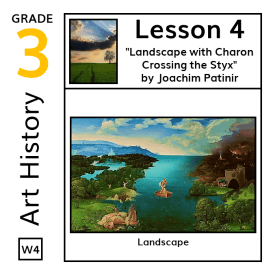
By: Joachim Patinir
Week: 4
Joachim Patinir's 'Landscape with Charon Crossing the Styx' is a special type of landscape painting called a 'world landscape.' World landscapes portray expansive views-on-high of imaginary lands populated by tiny figures and sometimes include real world landmarks. 'Landscape with Charon Crossing the Styx' shows the character, Charon, from two works of literature, Virgil's Aeneid and Dante's Inferno. Charon ferries the souls of the dead from the land of the living to the land of Hades. In the paining, Charon, ferries a soul down the river Styx. The soul must choose between the angelic glories of Heaven on the left and the demonic fires of Hell on the right. Note the inclusion of Cerberus, the three-headed dog, who guards the gates of hell.
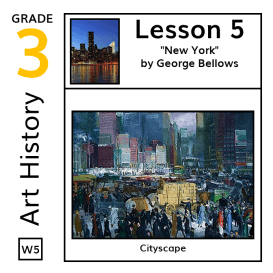
By: George Bellows
Week: 5
In George Bellows' cityscape, 'New York,' a bustling crowd of pedestrians, carts, trucks, trolley cars, and horses struggle to travel to their destinations. Many-windowed skyscrapers and belligerent advertisements tower over the hustle and chaos of the city. The heavy winter coats, bare trees, and the patch of snow covering a park reveal the season is winter. This cityscape depicts an imaginary composite of multiple places in New York City. The painting, completed in 1911, captures a unique time of transition, when horses still travel among motorized vehicles on the city roads.
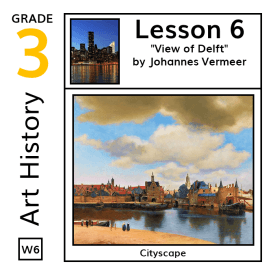
By: Johannes Vermeer
Week: 6
Johannes Vermeer's 'View of Delft' shows the city of Delft in the Netherlands. This cityscape painting is noteworthy as it was completed in 1661, a time before cityscapes became common. The painting features one of the canals which flow within the city. Two peasant women talk alongside the canal. Further to the left, next to a barge in the water, two men chat with a woman, and another woman holds a child. Smaller figures go about their business on the far side of the canal, where sailing ships are moored. At the far right of the painting, the Rotterdam gate stands under double turrets. The dignified, white New Church tower presides as the highest building in the area, dwarfing the grayish Old Church tower, which breaks the plane of red roofs to the far left. The lightly rippled water has a glossy sheen and reflects the shadows of the buildings.
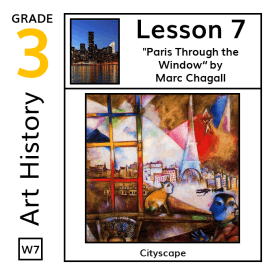
By: Marc Chagall
Week: 7
Marc Chagall's 1914 painting, 'Paris Through the Window,' shows a surreal window-view of the city of Paris in France. A two-faced man with a heart on his hand appears in the lower right-hand corner. A cat with a human face sits on the window ledge, perhaps watching the man in a hat holding a triangular parachute and floating through the air. A man and woman in black float horizontally. A train choo-choos itself upside down. The window frame and sky are a kaleidoscope of bright colors and geometric shapes. A chair back in the lower right appears to sprout real flowers. The buildings of Paris and unmistakable form of the Eiffel Tower provide the backdrop for the delightful absurdity.
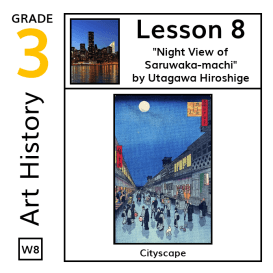
By: Utagawa Hiroshige
Week: 8
Utagawa Hiroshige's 'Night View of Saruwaka-machi' depicts a scene from Saruwaka-machi, a theater town from years past in Japan. A busy street divides kabuki theaters on the right and teahouses on the left. A watchful dog stands guard over a group of rollicking puppies. A full moon lingers over the people milling in the street, casting shadows toward the viewer. Some people carry glowing red and white lanterns to light the way home. 'Night View of Saruwaka-machi' is a woodblock print. Rather than being painted directly upon paper with a brush, the image is carved in relief from wood, similar to a rubber stamp. Ink is applied to the wooden block, and then the block is pressed upon paper. This work falls into an art genre called ukiyo-e, which features images such as beautiful ladies, sumo wrestlers, folk stories, landscapes, and in this case, a cityscape.
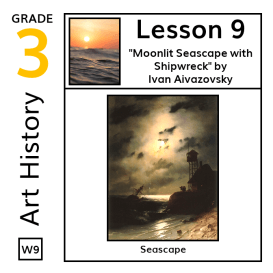
By: Ivan Aivazovsky
Week: 9
A section on seascapes and nautical art would not be complete without at least one work from Russian Romantic painter and master marine artist, Ivan Aivazovsky. Aivazovsky's 'Moonlit Seascape with Shipwreck' depicts a ship run aground off the coat in the dark of night. A glowing full moon peeps from between the clouds, illuminating the breaking waves glistening like gemstones and crashing against the sandy beach. The sea glows like molten gold near the horizon. A small group of people gather outside a modest hut and its wooden watchtower to watch the spectacle. One observer points at the people escaping the swamped ship in lifeboats.
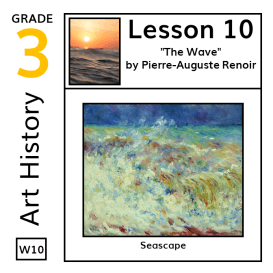
By: Pierre-Auguste Renoir
Week: 10
French impressionist Pierre-Auguste Renoir's seascape, 'The Wave,' encompasses a flurry of brushstrokes to depict a wave churning against the seashore. White sea spray dances into the air, showing the power of the wave. Multiple colors are used to create the crashing wave, including reds, yellows, blues, greens, and whites. Black strokes suggestive of boats sail the line where the sea meets the sky. The greens, blues, and yellows of the sea at the horizon contrast with the darker blues and purples of the sky.
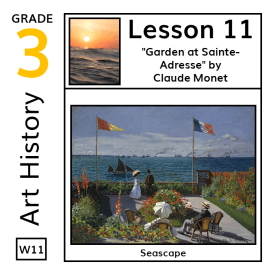
By: Claude Monet
Week: 11
Claude Monet's 'Garden at Sainte-Adresse' features a splendid sea view from a garden terrace. Men in hats and ladies beneath parasols enjoy the bright sunshine and brisk ocean breeze. The sea is mildly choppy and the sails of boats billow in the wind. Flowers bloom and vines tangle in the trellis fence. The blue, white, and red flag of France and a red and yellow sailing club flag flap atop flagpoles. Monet visited Sainte-Adresse with his family and painted his family members into the painting. His father served as the model for the man in the Panama hat closest to the viewer.
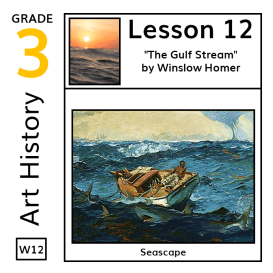
By: Winslow Homer
Week: 12
Winslow Homer's 'The Gulf Stream' portrays the survivor of a stormy sea floating in a floundering fishing boat, most likely somewhere near Florida and the Caribbean. The man's survival is not assured, as sharks circle his boat, rambunctious waves crest in the distance, and a waterspout looms on the horizon. However, there is hope. A three-masted sailing vessel is barely visible amidst the clouds. Will the sailors see the man? Will they reach him in time before his boat capsizes or he succumbs to dehydration?
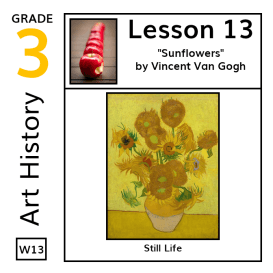
By: Vincent Van Gogh
Week: 13
Dutch painter Vincent van Gogh created two series of still life paintings featuring sunflowers. The first series featured loose sunflowers lying horizontally. The second series featured sunflowers in vases. This painting, 'Sunflowers F458,' is a repetition of an earlier painting from the second series. In this painting, sunflowers in various states, many missing petals, others with crooked stems, bloom from a yellow vase adorned with the name, "Vincent." The surface supporting the sunflowers and the wall behind the sunflowers are in shades of yellow. This painting is currently hosted in the Van Gogh museum in the Netherlands.
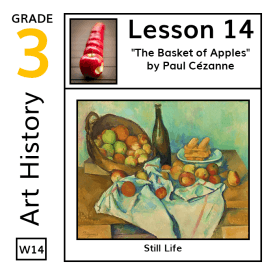
By: Paul Cézanne
Week: 14
French painter Paul Cézanne's still life, 'The Basket of Apples,' is a fascinating study of balance. Cookies balance crossways in orderly layers upon a plate. Contrasting the cookies, the bottle slightly tilts and the basket tips forward to spill out a jumble of apples. Even the table is disjointed, as if split into two pieces down the middle, higher on the right than the left.
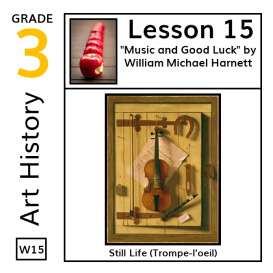
By: William Michael Harnett
Week: 15
Irish-American painter William Michael Harnett's still life, 'Music and Good Luck,' presents a special kind of still life painting called 'trompe-l'oeil,' which means 'deceive the eye.' Trompe-l'oeil artists use optical illusions to create two-dimensional paintings with the appearance of three-dimensions. Look closely at 'Music and Good Luck' to see how Hartnett employed imperfections, perspective, texture, and shading to suggest realism and three-dimensions. This work strives to accentuate the viewer's sense of reality by highlighting flaws instead of hiding them. Painted flaws include the rusted metals, splintered wood, nail holes, stains, and rips.
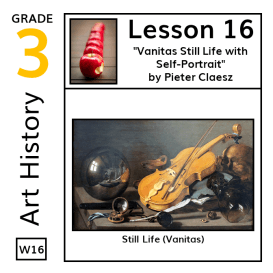
By: Pieter Claesz
Week: 16
Dutch painter Pieter Claesz's 'Vanitas Still Life with Self-Portrait' is a special kind of still life called a 'vanitas.' In vanitas artwork, the objects symbolize 'the transience of life, the futility of pleasure, and the certainty of death.' ('Veritas' entry on Wikipedia.org) This painting features a violin and its bow, a glass mirror ball, an extinguished oil lamp, a face-down pocket watch with its back open to expose its inner gears, a cracked nut, an overturned glass roemer, a skull, a book, folders, papers, an overturned inkwell, a black pen holder, and a quill. Look closely at the glass ball to expand your view of the room. Note the brightly lit window, the beams of the ceiling, the doorways, the chairs, and the artist sitting at his easel while creating this painting. Note how the objects emphasize the fleeting passage of time and transience of life - the wine has been consumed, the lamp is extinguished, the ink is expended, and perhaps the pocket watch has stopped.
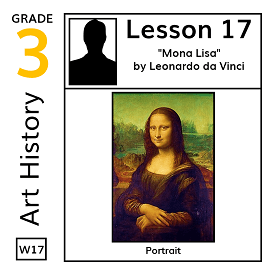
By: Leonardo da Vinci
Week: 17
Italian artist and inventor Leonardo da Vinci's portrait, 'Mona Lisa,' is one of the most famous and valuable paintings in the world. Mona Lisa is thought to be a portrait of a real woman named Lisa del Giocondo, the wife of a Florentine silk merchant. The Italian word 'mona' is similar in meaning to 'madam' or 'my lady' in English. In the painting, Mona Lisa sits in a chair with her arms folded. Behind her is an imaginary far off landscape of paths, a bridge, and snowy mountains. It is Mona Lisa's mysterious expression that captivates viewers. In 1911, the painting was stolen from the Louvre museum in Paris before it was recovered two years later. The Italian thief, a Louvre employee, who kept the painting in his apartment for two years before he sold it to museum in Italy, later claimed his motive was to repatriate the painting to Italy, although money may have been the true motivating factor. Although the painting was created in the early 1500s, it was only after the theft that the painting became famous outside the art world. Vandals also sprayed the painting with acid and threw a rock at it in the 1950s. The painting was later put behind bulletproof glass to protect it.
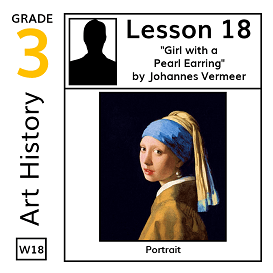
By: Johannes Vermeer
Week: 18
Dutch artist Johannes Vermeer's portrait, 'Girl with a Pearl Earring,' is well-known for the fictitious novel, play, and movie it inspired. The painting is of a lovely young girl, wearing an ornate dress, a turban, and an enormous pear-shaped pearl earring. This portrait is a special kind of painting called a 'tronie.' Tronies typically depict imaginary people and focus on the facial expressions and elaborate costuming of the subjects.
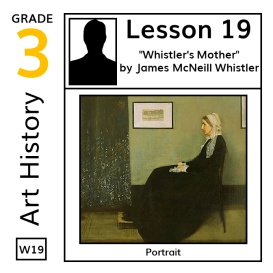
By: James McNeill Whistler
Week: 19
American James McNeill Whistler's 'Whistler's Mother' is a portrait of the artist's mother, Anna McNeill Whistler. The painting consists of severe shades of black, white, and grey and features many right angles. Wearing a severe expression, Anna Whistler sits rigidly upright on a chair, her feet clad in black shoes and propped up on a footrest. She wears a black dress with lace trim and a white lacy head covering. She also holds a lacy handkerchief. Two paintings in black frames hang on the gray and black wall. A grey and white floral curtain hangs motionless from the ceiling. Gray and black carpeting features a square pattern. Whistler's Mother is one of the most famous American artworks around the world. Over the years, this painting has been shown or mentioned in several movies and television shows, featured in a 1934 stamp, and immortalized in an 8-foot-tall statue in Pennsylvania.
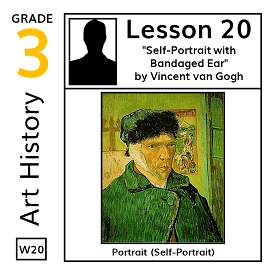
By: Vincent van Gogh
Week: 20
Dutch artist Vincent van Gogh's portrait, 'Self-Portrait with Bandaged Ear,' was painted shortly after he was released from the hospital after losing his ear. Van Gogh is reputed to have cut off his own ear, although some historians believe he might have lied to protect his friend and fellow artist, Paul Gauguin, who may have cut Van Gogh's ear off with a sword during an argument. Note that the painting is a mirror image - it was actually Vincent van Gogh's left ear that was cut off. His ear is heavily bandaged, and he wears a warm furry hat and green overcoat. The background shows a canvas on an easel. The painting also includes a reproduction of a print by Sato Torakiyo, a Japanese print featuring Mount Fuji and women holding fans that hung in Van Gogh's studio. This work is a special type of portrait called a 'self-portrait,' when the artist paints their own portrait.
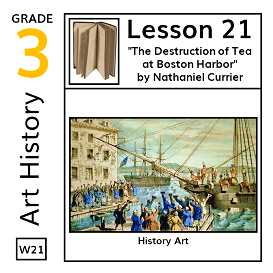
By: Nathaniel Currier
Week: 21
In the American Revolution, the American colonists fought for independence from the British. Nathaniel Currier's painting, 'The Destruction of Tea at Boston Harbor,' captured one event in 1773 that helped to lead to war. The painting depicts the Boston Tea Party, a colonial protest against British taxes on tea. During the protest, the Sons of Liberty dressed as American Indians and tossed three entire boats-worth of British tea into Boston Harbor.
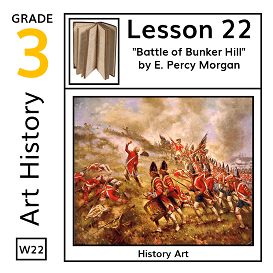
By: E. Percy Morgan
Week: 22
In 1782, seven years after the Battle of Bunker Hill, an American delegation traveled to Paris, France to negotiate a peace treaty with the British to end the Revolutionary War. Benjamin West's painting, 'American Commissioners of the Preliminary Peace Agreement with Great Britain,' shows only the American delegation. The British delegation is missing. It is said the British delegation refused to sit for the picture. West left the painting unfinished as a testament to the division that remained between the Americans and the British.
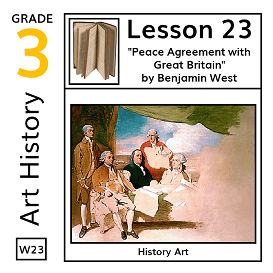
By: Benjamin West
Week: 23
In 1782, an American delegation traveled to Paris, France to negotiate a peace treaty to end the Revolutionary War between the Americans and the British. Benjamin West's painting, painted live in Paris, 'American Commissioners of the Preliminary Peace Agreement with Great Britain,' shows only the American delegation, while the British delegation is missing and the painting is unfinished. It is said the British delegation refused to sit for the picture. West left the painting unfinished as a testament to the division that remained between the Americans and the British.
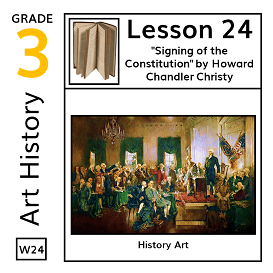
By: Howard Chandler Christy
Week: 24
After the American colonists won independence from the British, in 1787 they signed the Constitution of the United States of America. Howard Chandler Christy's painting, 'Scene at the Signing of the Constitution of the United States,' features 40 of the 53 delegates at the official signing, which took place at Independence Hall in Philadelphia, Pennsylvania. George Washington is prominently featured standing on the raised platform as delegates from North Carolina sign the document. Right below Washington is Benjamin Franklin, who sits over a pile of books.
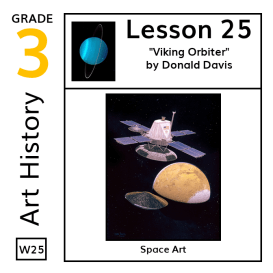
By: Donald Davis
Week: 25
Donald Davis' 'Viking Orbiter' shows an unmanned space probe near the planet Mars in 1975. The space probe was shot into space atop a rocket, traveled to Mars, orbited around the planet, and took pictures to figure out a good place to land. The orbiter carried a lander, which traveled down to land upon the Martian surface to take pictures and measurements. The painting shows the lander detached from the orbiter, ready to travel down to the reddish, cratered surface of Mars. Note how Mars is half in shadow and half in sunlight, just like the earth. Also note the white polar ice caps on Mars.
By: Donald Davis
Week: 26
Donald Davis' 'Big Impact' shows a planetoid smashing into Earth. Note the cratered surface of the planetoid and the ring of matter ejected from the surface of the earth.
By: R. Hurt
Week: 27
R. Hurt's 'Fallback Disk Around Pulsar 4U 0142+61' shows a pulsar surrounded by a disk of rocky matter and debris as well as a purple cloud of hot gas. A recent collapse of a star created the pulsar and fallback disk. The pulsar gets its name because it spins quickly and produces pulses of radiation. The black, starry expanse of outer space creates the backdrop.
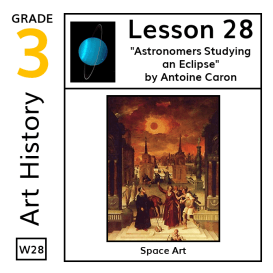
By: Antoine Caron
Week: 28
Antoine Caron's 'Astronomers Studying an Eclipse' shows people responding to a solar eclipse. Lightning streaks across the clouds as the sun looms dark in a red sky. Closest to the viewer, a putto scribbles something on a notebook. The bearded gentleman in black uses a pointer to prod an armillary sphere. Behind the gentleman in black, a man wears a red robe, leans over, and draws or measures on paper with a compass. The central figure in red holds a book and points up to the sky. A man in white, holds a tan celestial globe under his arm. In the background, a man wearing a hat reads from a book as a globe rests at his feet. Farther in the background, we see people panicking and fleeing, perhaps fearing the end of the world. In times past, people believed eclipses signified dire circumstances such as an imminent apocalypse. Today, we know that a solar eclipse is caused when the moon lines up between the earth and the sun to block the sun's light.
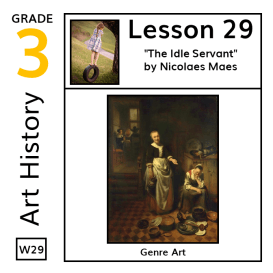
By: Nicolaes Maes
Week: 29
In Dutch artist Nicolaes Maes' 'The Idle Servant,' the mistress of the house smiles directly at the viewer as she gestures to an idle servant who has fallen asleep on the job. A pile of dishes, including ladles, pots, plates, and a strainer, lay akimbo across the checkered floor. Adding to the sense of chaos, cat grabs a fowl off a plate. Steps and a bannister lead up to a group sitting and conversing around the table.
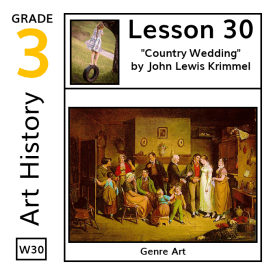
By: John Lewis Krimmel
Week: 30
In American artist John Lewis Krimmel's 'Country Wedding,' family and friends cram into small room in a country house for a modest wedding ceremony. Two birds, a cat, and a dog witness the spectacle. The bride and bridegroom hold hands and incline their heads toward one another as the officiant leads the ceremony. A girl sitting on a stool tries to make a small boy holding a whip behave. One woman wipes a tear from her eye. The best man and maid of honor pay more attention to the distractions of the wedding guests than the nuptials.
By: Hendrick Avercamp
Week: 31
Dutch painter Hendrick Avercamp's 'Winter Scene on a Canal' reveals a winter wonderland of fun and excitement. People slip, slide, and skate up and down a frozen canal. Snow frosts the trees and buildings. People watch the festivities from a house. Boats sit useless, embedded in the frozen ice.
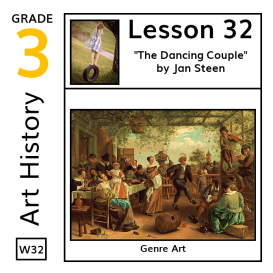
By: Jan Steen
Week: 32
In Dutch artist Jan Steen's 'The Dancing Couple,' a couple takes center stage, the man wearing a jaunty beret while kicking and smiling and the woman revealing a shy smile, but not yet dancing. Boy musicians play a flute and a violin over a little boy blowing bubbles. People feast and drink at a banquet table. Steen painted himself sitting at the table, touching a woman's chin as she drinks from her glass. A child holding a toy stands on her adoring mother's lap. A man with a chicken in a cage on his head and small girl holding a pinwheel peer over a railing. Various items litter the floor, including an empty barrel, a tea pot, an overturned bucket of flowers, broken eggshells, a spoon, and a tiny shoe. Birds in a cage dangle from an arbor tangled with green vines.
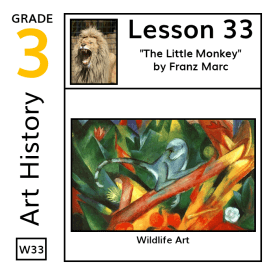
By: Franz Marc
Week: 33
In German wildlife artist Franz Marc's expressionist painting, 'The Little Monkey,' a gray monkey sits on a branch amidst a jumble of brightly colored tropical flowers and fruits. The monkey has a white belly and a black and grey ringed tail, and looks behind him, as if he's heard something.
By: Henri Rousseau
Week: 34
In French wildlife artist Henri Rousseau's primitivist painting, 'Exotic Landscape (1908),' a variety of animals peep from the lush foliage of the jungle. One primate plucks a juicy orange from a tree. A tropical bird in red and blue provides a central focal point.
By: Sir Edwin Landseer
Week: 35
In English painter Edwin Landseer's painting, 'The Monarch of the Glen,' a stag stands with its head high before the dramatic backdrop of rocky mountains. The painting title is a bit of a misnomer since the stag's twelve-point antlers only qualifies him as a 'royal stag.' A 'monarch stag' requires at least 16 points on his antlers.
By: Henri Rousseau
Week: 36
In French wildlife artist Henri Rousseau's expressionist painting, 'Surprised,' a wide-eyed tiger crouches to attack its prey. What is the tiger's prey? We don't know, since the prey hides outside the view of the painting. Rain and lightning pound down from the tumultuous sky. The jungle leaves and grasses whip in the wind. This painting is also known as 'Tiger in a Tropical Storm.'